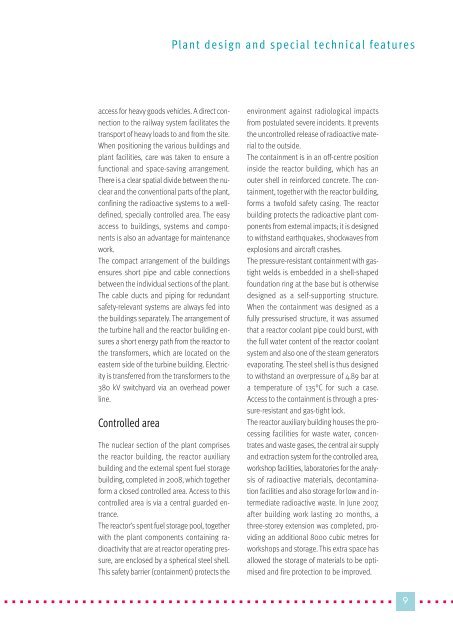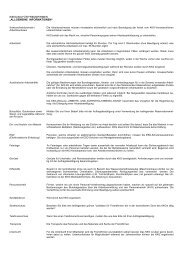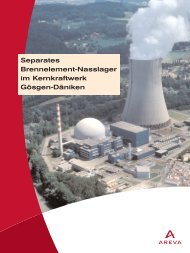Technology and Operation - Kernkraftwerk Gösgen
Technology and Operation - Kernkraftwerk Gösgen
Technology and Operation - Kernkraftwerk Gösgen
Create successful ePaper yourself
Turn your PDF publications into a flip-book with our unique Google optimized e-Paper software.
access for heavy goods vehicles. A direct connection<br />
to the railway system facilitates the<br />
transport of heavy loads to <strong>and</strong> from the site.<br />
When positioning the various buildings <strong>and</strong><br />
plant facilities, care was taken to ensure a<br />
functional <strong>and</strong> space-saving arrangement.<br />
There is a clear spatial divide between the nuclear<br />
<strong>and</strong> the conventional parts of the plant,<br />
confining the radioactive systems to a welldefined,<br />
specially controlled area. The easy<br />
access to buildings, systems <strong>and</strong> components<br />
is also an advantage for maintenance<br />
work.<br />
The compact arrangement of the buildings<br />
ensures short pipe <strong>and</strong> cable connections<br />
between the individual sections of the plant.<br />
The cable ducts <strong>and</strong> piping for redundant<br />
safety-relevant systems are always fed into<br />
the buildings separately. The arrangement of<br />
the turbine hall <strong>and</strong> the reactor building ensures<br />
a short energy path from the reactor to<br />
the transformers, which are located on the<br />
eastern side of the turbine building. Electricity<br />
is transferred from the transformers to the<br />
380 kV switchyard via an overhead power<br />
line.<br />
Controlled area<br />
The nuclear section of the plant comprises<br />
the reactor building, the reactor auxiliary<br />
building <strong>and</strong> the external spent fuel storage<br />
building, completed in 2008, which together<br />
form a closed controlled area. Access to this<br />
controlled area is via a central guarded entrance.<br />
The reactor’s spent fuel storage pool, together<br />
with the plant components containing radioactivity<br />
that are at reactor operating pressure,<br />
are enclosed by a spherical steel shell.<br />
This safety barrier (containment) protects the<br />
Plant design <strong>and</strong> special technical features<br />
environment against radiological impacts<br />
from postulated severe incidents. It prevents<br />
the uncontrolled release of radioactive material<br />
to the outside.<br />
The containment is in an off-centre position<br />
inside the reactor building, which has an<br />
outer shell in reinforced concrete. The containment,<br />
together with the reactor building,<br />
forms a twofold safety casing. The reactor<br />
building protects the radioactive plant components<br />
from external impacts; it is designed<br />
to withst<strong>and</strong> earthquakes, shockwaves from<br />
explosions <strong>and</strong> aircraft crashes.<br />
The pressure-resistant containment with gastight<br />
welds is embedded in a shell-shaped<br />
foundation ring at the base but is otherwise<br />
designed as a self-supporting structure.<br />
When the containment was designed as a<br />
fully pressurised structure, it was assumed<br />
that a reactor coolant pipe could burst, with<br />
the full water content of the reactor coolant<br />
system <strong>and</strong> also one of the steam generators<br />
evaporating. The steel shell is thus designed<br />
to withst<strong>and</strong> an overpressure of 4.89 bar at<br />
a temperature of 135°C for such a case.<br />
Access to the containment is through a pressure-resistant<br />
<strong>and</strong> gas-tight lock.<br />
The reactor auxiliary building houses the processing<br />
facilities for waste water, concentrates<br />
<strong>and</strong> waste gases, the central air supply<br />
<strong>and</strong> extraction system for the controlled area,<br />
workshop facilities, laboratories for the analysis<br />
of radioactive materials, decontamination<br />
facilities <strong>and</strong> also storage for low <strong>and</strong> intermediate<br />
radioactive waste. In June 2007,<br />
after building work lasting 20 months, a<br />
three-storey extension was completed, providing<br />
an additional 8000 cubic metres for<br />
workshops <strong>and</strong> storage. This extra space has<br />
allowed the storage of materials to be optimised<br />
<strong>and</strong> fire protection to be improved.<br />
� � � � � � � � � � � � � � � � � � � � � � � � � � � � � � � � � � � � � � � � � � � � � � � � � � � 9�<br />
� � � � � �




